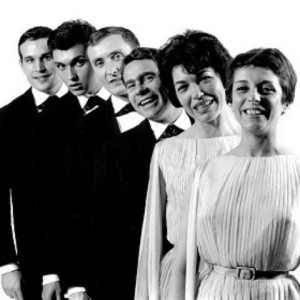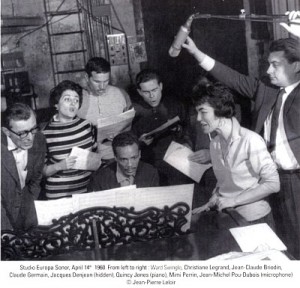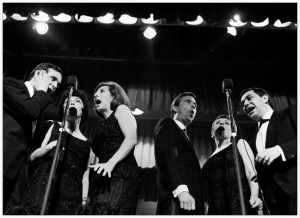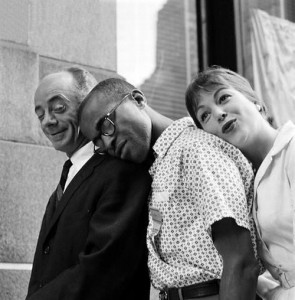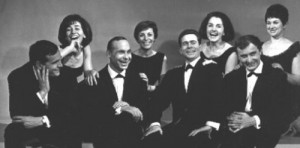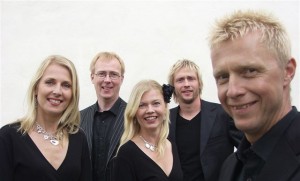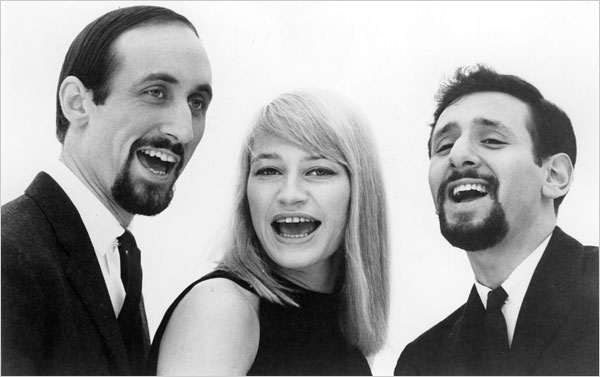Les Double Six of Paris, Moanin’
Oh, those French. Don’t you just love it when they try to outdo Americans in appreciating American jazz? Sometimes it works, as in Bernard Travernier’s touching 1986 film “’Round Midnight”, starring saxophone great Dexter Gordon as an amalgam of real expat Black musicians in Paris in the 1950s.
But there’s a special pleasure (for us Americans) when they fall on their froggy faces trying to imitate it, so that we can condescend from our culturocentric comfort zone, titting for tat that hard-coded snobbism that seems to be their veritable raison d’etre.
The vocal jazz groups of the 1930s and 1940s (The Boswell Sisters, The Ames Brothers, The Andrews Sisters) all sang in melodious, pleasing tight harmony, in the style of the Big Bands they often fronted. After WWII, Charlie Parker kicked jazz into the modern era with his be-bop – frenetic, witty, ironic, faster than the ear can hear. Vocal groups couldn’t keep up.
Les Double Six – ‘Boplicity’ (live video)
Only a decade later, in 1959, Mimi Perrin got together in Paris a sextet of jazz enthusiasts to recreate the au courant bop music in a vocal setting. They took recordings of Dizzy Gillespie, Ray Charles, but mostly Count Basie and the young Quincy Jones, copied them note-for-note, including the improvised solos, all set to lyrics written by Perrin. Then they double-tracked it all (a new technology) for breadth – hence Les Double Six of Paris.
It was undeniably a remarkable achievement. To my mind, with apologies to Dr. Johnson: ‘Sir, six French singers attempting to replicate virtuoso American jazz is like a dog’s walking on his hind legs. It is not done well; but you are surprised to find it done at all.’
Let’s take a listen to an original and its French cover.
“Moanin’” was written by pianist Bobby Timmons for drummer Art Blakey’s star-breeding hard-bop group The Jazz Messengers. Hard Bop is jazz’s Motown – brash and Black, funky and fun, superficial and sexy. Blue Note was almost as dominant a label for hard bop (second half of the 1950s) as Motown was for its very own brand of pop-commercial rhythm and blues/soul (throughout the 1960s). Both were created by Blacks and bought by Whites. In the beginning, Motown was recorded in Berry Gordy’s Detroit garage, whereas hard bop was recorded in the Englewood, NJ, living room of dentist Rudy Van Gelder (whose wife is probably still complaining about it today).
“Moanin’” became a hard-bop hit, covered by artists as disparate as Charles Mingus, Ray Charles (arranged by Q. Jones), Lambert Hendricks & Ross (more about them below), British fingerpicker Davey Graham (remember Paul Simon’s cover of his ‘Anji’?) and two graven images from American Idol.
The source here isn’t Art Blakey’s original, but rather Quincy Jones’ cover. And here’s Les Double Six’s version, entitled ‘La complainte du bagnard’ (‘The Convict’s Lament’). And for all you French speakers, here are Mimi Perrin’s lyrics, including those for Clark Terry’s trumpet solo and Paul Chambers’ bass solo.
For all you serious students of this trivia out there, here’s a compendium of Les Six and the originals. There will be a quiz on the material next week.
| Quincy Jones – Walkin’ | Les Double Six – Walkin’ |
Les Double Six were one of the two prominent vocal jazz groups of the late 1950s/early 1960s, together with the aforementioned Lambert Hendricks & Ross (who also overdubbed themselves on occasion, making them The Double Trio of New York). Both groups were intelligent, sophisticated, artistically sincere. Both leave me pretty cold, as do LH&S’s successors, Manhattan Transfer. All three of these groups, to my ears, are collectives of soloists singing virtuosic music in tandem – just like the hard boppers that they were copying.
Les Double Six recorded four albums from 1959-1964; LH&R about 10 during more or less the same period; and Manhattan Transfer innumerable ones from 1971 till today. None of the three really appeal to me. I don’t know why, they should. I admire all three, the first two greatly. I just don’t enjoy their music.
This is in contrast to two other offshoots, both of which appeal to me greatly. First is The Swingle Singers, a French octet led by American Ward Swingle, who together with many other of the Swingles graduated from Mimi Perrin’s collective (which, by the way, had a rather floating membership which differed for each recording session).
Swingle’s singers were friends who got together to sing some JS Bach as a sight-reading exercise, and found it no less swingable (employing a string bass and brushed drums) than Basie or Jones. They recorded an album of this material as a present for friends which went viral and won two Grammies.
For the second offshoot, you have to jump ahead almost 20 years to Stockholm, where five young Swedish music students were scouring around for something new to sing. They listened to Les Double Six and to LH&R, but went back to the Count Basie originals with a new approach. They became The Real Group, copying neither the original nor the copiers of the original, but genuinely recreating Basie’s scores with five voices – a cappella, no rhythm section to lean on.
They weave a polyphonic tapestry that reimagines in five voices the original 16-19 instruments. It’s technically mind-boggling, it’s beautiful and it’s riveting.
Here’s a Basie original (1957), and here’s The Real Group’s recreation of it. And here’s a looong, detailed interview I did with Peder Karlsson, a founding member of the group, about just how The Real Group’s music came into being.
The Real Group has spawned a whole little world of young cappella groups throughout the world, especially in Scandinavia. Here’s a stunning performance by the 12-voice Danish group, Touche, with their leader Jesper Holm’s arrangement of Count Basie’s ‘Shiny Stockings’.
I don’t know what Count Basie would say, but I think the vocal interpretations of his music have made a quantum leap forward over the 60 years since he first created it.
If you enjoyed this post, you may also like: Miles Davis, ‘Boplicity’ (“Birth of the Cool”) Swingle Singers, ‘Sinfonia’ (JS Bach) Kurt Elling, ‘Li’l Darlin’’ The Real Group, ‘Joy Spring’
